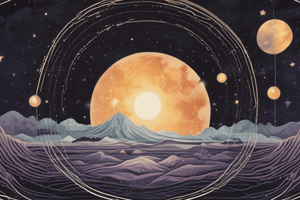Podcast
Questions and Answers
What happens to a star when its core runs out of hydrogen and helium?
What happens to a star when its core runs out of hydrogen and helium?
- The star instantly becomes a black hole.
- The star remains stable and continues to fuse hydrogen.
- The core contracts while the outer layers expand and cool. (correct)
- The core expands and increases in brightness.
What type of remnants are formed from low mass stars at the end of their life cycle?
What type of remnants are formed from low mass stars at the end of their life cycle?
- Planetary nebulae and then white dwarfs (correct)
- Neutron stars
- Black holes
- Red super giants
Which type of star expands into a red giant or red super giant during old age?
Which type of star expands into a red giant or red super giant during old age?
- Only low mass stars
- All main sequence stars regardless of mass
- Stars of low or intermediate mass only (correct)
- High mass stars exclusively
What characterizes a white dwarf?
What characterizes a white dwarf?
Which of the following correctly describes a protostar?
Which of the following correctly describes a protostar?
Flashcards are hidden until you start studying
Study Notes
Star Life Cycle
- Birth: Protostars originate from the contraction of nebulae, which are clouds formed of dust, hydrogen, helium, and ionized gases.
- Main Sequence: Approximately 90% of stars are in this phase, where they fuse hydrogen into helium in their cores. They vary significantly in size, ranging from one-tenth to 200 times the mass of the Sun.
- Old Age: Stars expand as they age. When hydrogen and helium are depleted, their cores contract, while outer layers expand, cool, and dim, transforming into red giants or red supergiants based on initial mass. These stars exhibit high luminosity and low surface temperatures, typically below 5,000 K.
- Death: Red supergiants, categorized under spectral types K or M, are the largest stars by volume. Notable examples include Betelgeuse and Antares. Upon exhausting their nuclear fuel, they can collapse and explode, leading to the formation of black dwarfs, neutron stars, or black holes, depending on their original mass.
- Remnants: Low-mass stars evolve into planetary nebulae, creating a glowing shell of ionized gas. This process leads to the formation of a white dwarf, a dense remnant comprised mainly of electron-degenerate matter. These remnants can be as dense as the Sun but are comparable in size to Earth. Over time, a white dwarf can cool down to become a black dwarf, which emits negligible heat or light.
Studying That Suits You
Use AI to generate personalized quizzes and flashcards to suit your learning preferences.




